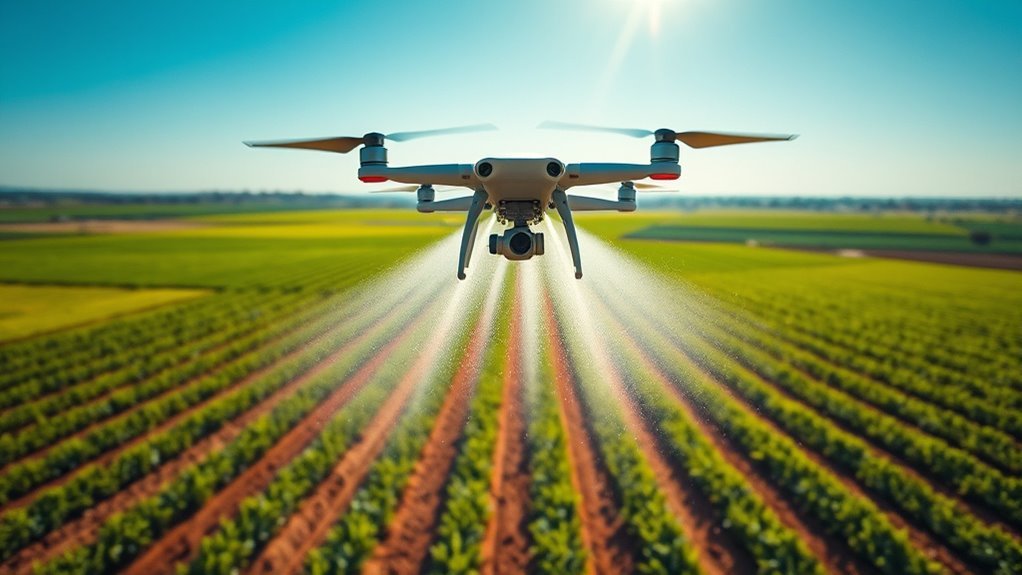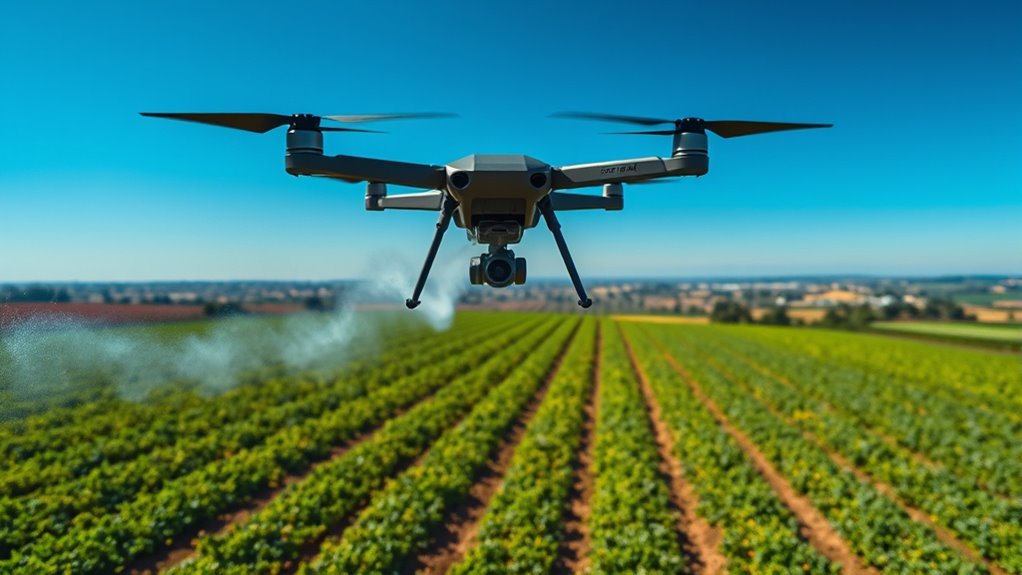Drones in the U.S. are spraying a variety of chemicals that include common pesticides like glyphosate and chlorpyrifos, as well as herbicides and nutrient solutions. These applications help manage crop health and enhance efficiency. However, it’s crucial to recognize the importance of regulatory compliance and the potential environmental and health impacts associated with such practices. By exploring further, you can uncover more details about these chemicals and their implications for agriculture.
Overview of Aerial Spraying in Agriculture

Aerial spraying in agriculture serves as an essential method for crop management, particularly when timely intervention is needed to protect against pests and diseases. As a farmer or agricultural professional, you’re likely aware of the increasing importance of sustainable practices. By integrating aerial spraying with innovative techniques, you can optimize crop health while minimizing environmental impact. Technological advancements in drone capabilities allow for precise application of treatments, ensuring that only targeted areas receive attention. This precision not only enhances efficiency but also reduces chemical runoff, aligning with eco-friendly goals. Adopting aerial spraying can elevate your farming approach, combining tradition with modern technology to safeguard your yields and promote sustainability in the agricultural landscape.
Common Pesticides Used in Drone Applications

While many farmers recognize the benefits of drone technology, understanding the common pesticides used in these applications is essential for effective pest management. Drones offer precision that can optimize pesticide usage, reducing waste and minimizing environmental impact. Here’s a look at some common pesticides and their potential alternatives:
| Pesticide | Common Use | Pesticide Alternatives |
|---|---|---|
| Glyphosate | Weed control | Vinegar, salt |
| Chlorpyrifos | Insect control | Neem oil, insecticidal soap |
| Atrazine | Herbicide | Corn gluten meal |
| 2,4-D | Broadleaf weed control | Organic herbicides |
| Imidacloprid | Insecticide | Beneficial insects |
Exploring these options can empower you to make informed choices for sustainable farming practices.
Fertilizers and Nutrient Solutions Delivered by Drones

When you consider the use of drones for delivering fertilizers and nutrient solutions, it’s essential to weigh the benefits of precision agriculture against potential environmental impacts. Drones enable targeted application, which can enhance crop yields while minimizing waste. However, the risk of runoff and chemical accumulation poses significant concerns that warrant careful examination.
Precision Agriculture Benefits
As precision agriculture continues to evolve, the use of drones for delivering fertilizers and nutrient solutions has emerged as a game-changer for farmers. You can greatly enhance crop monitoring and yield optimization through this technology. Here are some benefits:
- Targeted Application: Drones can precisely spray fertilizers where needed, reducing waste.
- Efficiency: They cover large areas quickly, minimizing labor and time.
- Data Insights: Drones gather real-time data, helping you make informed decisions about crop health.
- Cost-Effectiveness: By optimizing input usage, you lower overall costs while maximizing productivity.
With these advancements, you’re not just improving efficiency; you’re also empowering your farming practices, ensuring greater freedom in managing your agricultural operations.
Environmental Impact Concerns
The use of drones for spraying fertilizers and nutrient solutions, despite its many advantages, raises significant environmental concerns. While these technologies can enhance crop efficiency, they also pose risks related to chemical exposure. Excessive application of fertilizers can lead to runoff, contaminating local water sources and disrupting ecosystem balance. This runoff can trigger algal blooms, depleting oxygen levels and harming aquatic life. Furthermore, the precise nature of drone spraying doesn’t eliminate the potential for over-application, which can further harm soil health and biodiversity. As you consider the benefits of drone technology, it’s essential to weigh these environmental impacts. Sustainable practices must be prioritized to maintain harmony with nature while still utilizing innovative agricultural solutions.
Herbicides and Their Impact on Crop Management
When considering herbicides in crop management, it’s essential to understand the various types used and their specific applications. You’ll find that drone technology has revolutionized how these chemicals are applied, enhancing efficiency and precision. However, it’s also important to address the environmental impacts associated with their use, as these concerns can markedly affect farming practices and sustainability.
Types of Herbicides Used
Herbicides play an essential role in modern agriculture, particularly in managing weed populations that threaten crop yields. With the rise of drone technology, the application of these chemicals has become more efficient and precise. However, as you navigate this landscape, it’s vital to understand the types of herbicides used and their implications, especially concerning herbicide resistance. Here are four common types:
- Glyphosate – A broad-spectrum herbicide effective against many weeds.
- 2,4-D – Used primarily for controlling broadleaf weeds in cereal crops.
- Atrazine – A pre-emergent herbicide that targets grassy and broadleaf weeds.
- Dicamba – Known for its effectiveness against tough-to-control weeds.
Recognizing these options can help you make informed decisions regarding crop management strategies.
Application Techniques Overview
Understanding the types of herbicides is just the first step; applying them effectively is where the real challenge lies. Drone technology has revolutionized the application of herbicides, allowing for precise targeting and reduced chemical exposure compared to traditional methods. However, the techniques used can greatly impact crop management outcomes.
| Application Technique | Benefits | Challenges |
|---|---|---|
| Aerial Spraying | Covers large areas quickly | Wind can affect accuracy |
| Ground Spraying | Targeted application | Slower, less efficient |
| Precision Agriculture | Data-driven decisions | Requires technology training |
Environmental Impact Concerns
While many farmers rely on herbicides for effective crop management, the environmental impact of these chemicals raises significant concerns. The use of drone technology for spraying can amplify chemical exposure, leading to potential consequences that can’t be ignored. Consider these factors:
- Soil Health: Herbicides can disrupt microbial communities essential for soil fertility.
- Water Contamination: Runoff can carry chemicals into local waterways, harming aquatic life.
- Biodiversity Loss: Non-target species may suffer from exposure, impacting the ecosystem balance.
- Human Health Risks: Prolonged exposure to herbicides raises potential health issues for farmworkers and nearby communities.
Understanding these impacts helps you make informed decisions about crop management practices, balancing productivity with environmental stewardship.
Regulatory Framework Governing Aerial Chemical Use
As the use of drones for aerial chemical application expands, it’s crucial to navigate the complex regulatory framework that governs this practice. You’ll find that regulatory compliance is paramount, as both federal and state agencies impose specific regulations on drone operators. The Federal Aviation Administration (FAA) oversees airspace use, while the Environmental Protection Agency (EPA) regulates the chemicals applied, guaranteeing they meet safety standards. Additionally, operators must adhere to state-specific guidelines that may vary considerably. Understanding these regulations not only guarantees legal operation but also promotes responsible use of chemical agents, safeguarding public health and the environment. By staying informed on the regulatory landscape, you can effectively utilize drones while respecting the rights and safety of others.
Environmental and Health Concerns Surrounding Drone Spraying
Given the increasing reliance on drones for chemical spraying, it’s vital to examine the potential environmental and health repercussions associated with this practice. Concerns about public health and ecological balance arise, including:
The rise of drone-assisted chemical spraying necessitates a careful evaluation of its health and environmental impacts.
- Pesticide resistance: Overuse can lead to resistant pests, complicating future management.
- Water contamination: Chemicals can leach into local waterways, affecting aquatic life and drinking supplies.
- Air quality: Drift from aerial applications may pose respiratory risks to nearby communities.
- Biodiversity loss: Non-target species, including pollinators, may suffer from exposure to harmful chemicals.
As you consider the implications of drone spraying, it’s important to weigh the benefits against these significant risks to guarantee a sustainable future that respects both health and the environment.
Frequently Asked Questions
How Are Drone Chemicals Regulated at the State Level?
State regulations vary considerably, impacting how drone chemicals are managed. You’ll find chemical oversight often involves permits, safety guidelines, and monitoring to guarantee public safety while balancing the need for innovation and agricultural efficiency.
What Are the Potential Long-Term Effects of Drone Spraying?
Imagine a world where skies once clear are now tainted. The potential long-term effects of drone spraying include significant environmental impact and health concerns, raising questions about sustainability and the balance between technology and nature’s integrity.
Can Drones Spray Organic Pesticides?
Yes, drones can spray organic pesticides, offering an efficient method for organic farming. They enable precise application of pesticide alternatives, reducing chemical runoff and promoting sustainable practices, aligning with your desire for environmentally conscious agricultural solutions.
How Accurate Are Drones in Applying Chemicals?
Drones in precision agriculture provide high accuracy in aerial application, often achieving up to 90% precision. This efficiency minimizes chemical use and environmental impact, allowing you to manage crops more effectively while supporting sustainable practices.
What Happens to Non-Target Organisms During Spraying?
Imagine a tightrope walker; non-target impacts can destabilize the ecological balance. When chemicals are sprayed, unintended consequences may harm beneficial organisms, disrupting their roles and further affecting the environment’s delicate harmony. Your awareness is essential.

